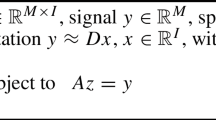Abstract
In order to enhance the robustness of image compression sensing system and reduce the mutual coherence between measurement matrix and sparse basis, this paper proposes an image measurement matrix optimization algorithm based on posterior information. Based on the traditional measurement matrix optimization model, the proposed algorithm considers the image reconstruction error from the OMP algorithm and uses it as a regular term. Matrix F-norm expansion and singular value decomposition are used to reduce the computational complexity and ensure the convergence of algorithm. Besides, the gradient matrix method is used to iteratively solve the measurement matrix. The proposed measurement matrix optimization model makes full use of the reconstruction error information of the image itself, not only improves the robustness of image compression sensing system, but also reduces the mutual coherence between the measurement matrix and the sparse basis. Experiments results show that compared with the state-of-the-art measurement matrix optimization algorithms, the proposed algorithm can reduce the average correlation coefficient more effectively, and the peak signal-to-noise ratio of the image can be increased by up to 1.2 dB.




Similar content being viewed by others
Data Availability
The data that support the findings of this study are available from the corresponding author upon reasonable request.
References
V. Abolghasemi, S. Ferdowsi, S. Sanei, A gradient-based alternating minimization approach for optimization of the measurement matrix in compressive sensing. Signal Process. 92(4), 999–1009 (2012)
R.G. Baraniuk, Compressive sensing [lecture notes]. IEEE Signal Process. Mag. 24(4), 118–121 (2007)
E.J. Candes, M.B. Wakin, An introduction to compressive sampling. IEEE Signal Process. Mag. 25(2), 21–30 (2008)
A. Cohen, W. Dahmen, R. Devore, Compressed sensing and best k-term approximation. J Ame Math Soc. 22(1), 211–231 (2009)
E.J. Candes, T. Tao, Decoding by linear programming. IEEE Trans. Inf. Theory 51(12), 4203–4215 (2005)
S.S. Chen, D.M.A. Saunders, Atomic decomposition by basis pursuit. SIAM Rev. 43(1), 129–159 (2001)
D.L. Donoho, Compressed sensing. IEEE Trans. Inf. Theory 52(4), 1289–1306 (2006)
D.L. Donoho, X. Huo, Uncertainty principles and ideal atomic decomposition. IEEE Trans. Inf. Theory. 47(7), 2845–2862 (2001)
E.M. Eksioglu, O. Bayir, K-SVD meets transform learning: transform K-SVD. IEEE Signal Process. Lett. 21(3), 347–351 (2014)
M. Elad, Optimized projections for compressed sensing. IEEE Trans. Signal Process. 55(12), 5695–5702 (2007)
T. Hong, H. Bai, S. Li, Z. Zhu, An efficient algorithm for designing projection matrix in compressive sensing based on alternating optimization. Signal Process. 125(2), 9–20 (2016)
T. Hong, Z. Zhu, Online learning sensing matrix and sparsifying dictionary simultaneously for compressive sensing. Signal Process. 153(12), 188–196 (2018)
T. Hong, Z. Zhu, An efficient method for robust projection matrix design. Signal Process. 143(3), 200–210 (2018)
D. Jiajun, B. Donghai, W. Qingpei, A novel multi-dictionary framework with global sensing matrix design for compressed sensing. Signal Process. 152, 69–78 (2018)
Q. Jiang, S. Li, H. Bai, R.C. Lamare, X. He, Gradient-based algorithm for designing sensing matrix considering real mutual coherence for compressed sensing systems. IET Signal Proc. 11(4), 356–363 (2017)
G. Li, X. Li, S. Li, H. Bai, Q. Jiang, X. He, Designing robust sensing matrix for image compression. IEEE Trans. Image Process. 24(12), 5389–5400 (2015)
G. Li, Z. Zhu, D. Yang, L. Chang, H. Bai, On projection matrix optimization for compressive sensing systems. IEEE Trans. Signal Process. 61(11), 2887–2898 (2013)
G. Li, Z. Zhu, X. Wu, On joint optimization of sensing matrix and sparsifying dictionary for robust compressed sensing systems. Digit Signal Process. 73(3), 62–71 (2018)
B. Russell, A. Torralba, W.T. Freeman, C. Labelme. The Open Annotation Tool, MIT. [Online]. Available: https://labelme2.csail.mit.edu//Release3.0/browserTools/php/dataset.php (2008).
C. Rusu, N. Gonzalez-Prelcic, Designing incoherent frames through convex techniques for optimized compressed sensing. IEEE Trans Signal Process. 64(9), 2334–2344 (2016)
T. Strohmer, R.W. Heath, Grassmannian frames with applications to coding and communication. Appl Comput Harmon Anal. 14(3), 257–275 (2004)
J.A. Tropp, Greed is good: algorithmic results for sparse approximation. IEEE Trans. Inf. Theory 50(10), 2231–2242 (2004)
J. Tropp, A.C. Gilbert, Signal recovery from random measurements via orthogonal matching pursuit. IEEE Trans. Inf. Theory 53(12), 4655–4666 (2007)
J. Xu, Y. Pi, Z. Cao, Optimized projection matrix for compressive sensing. Eurasip J Adv Signal Process. 43(2), 1–8 (2011)
M. Zibulevsky, M. Elad, L1–L2 Optimization in signal and image processing. IEEE Signal Process. Mag. 27(3), 76–88 (2010)
Acknowledgements
This work is supported by the National Natural Science Foundation of China (No. 61671095). The authors also would like to thank the anonymous reviewers for their valuable comments and suggestions.
Author information
Authors and Affiliations
Corresponding author
Additional information
Publisher's Note
Springer Nature remains neutral with regard to jurisdictional claims in published maps and institutional affiliations.
Rights and permissions
About this article
Cite this article
Zhao, H., Huang, C., Sun, C. et al. Posterior Information-Based Image Measurement Matrix Optimization. Circuits Syst Signal Process 40, 2361–2375 (2021). https://doi.org/10.1007/s00034-020-01573-w
Received:
Revised:
Accepted:
Published:
Issue Date:
DOI: https://doi.org/10.1007/s00034-020-01573-w




